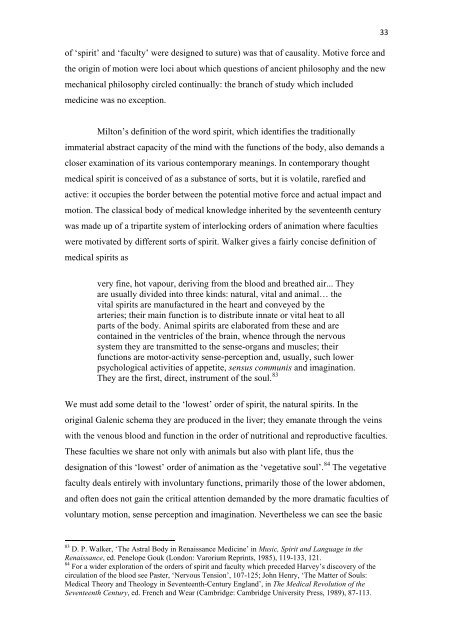Medical Science and the Anatomia Animata in Milton's Paradise Lost
Medical Science and the Anatomia Animata in Milton's Paradise Lost
Medical Science and the Anatomia Animata in Milton's Paradise Lost
You also want an ePaper? Increase the reach of your titles
YUMPU automatically turns print PDFs into web optimized ePapers that Google loves.
of ‘spirit’ <strong>and</strong> ‘faculty’ were designed to suture) was that of causality. Motive force <strong>and</strong><br />
<strong>the</strong> orig<strong>in</strong> of motion were loci about which questions of ancient philosophy <strong>and</strong> <strong>the</strong> new<br />
mechanical philosophy circled cont<strong>in</strong>ually: <strong>the</strong> branch of study which <strong>in</strong>cluded<br />
medic<strong>in</strong>e was no exception.<br />
Milton’s def<strong>in</strong>ition of <strong>the</strong> word spirit, which identifies <strong>the</strong> traditionally<br />
immaterial abstract capacity of <strong>the</strong> m<strong>in</strong>d with <strong>the</strong> functions of <strong>the</strong> body, also dem<strong>and</strong>s a<br />
closer exam<strong>in</strong>ation of its various contemporary mean<strong>in</strong>gs. In contemporary thought<br />
medical spirit is conceived of as a substance of sorts, but it is volatile, rarefied <strong>and</strong><br />
active: it occupies <strong>the</strong> border between <strong>the</strong> potential motive force <strong>and</strong> actual impact <strong>and</strong><br />
motion. The classical body of medical knowledge <strong>in</strong>herited by <strong>the</strong> seventeenth century<br />
was made up of a tripartite system of <strong>in</strong>terlock<strong>in</strong>g orders of animation where faculties<br />
were motivated by different sorts of spirit. Walker gives a fairly concise def<strong>in</strong>ition of<br />
medical spirits as<br />
very f<strong>in</strong>e, hot vapour, deriv<strong>in</strong>g from <strong>the</strong> blood <strong>and</strong> brea<strong>the</strong>d air... They<br />
are usually divided <strong>in</strong>to three k<strong>in</strong>ds: natural, vital <strong>and</strong> animal… <strong>the</strong><br />
vital spirits are manufactured <strong>in</strong> <strong>the</strong> heart <strong>and</strong> conveyed by <strong>the</strong><br />
arteries; <strong>the</strong>ir ma<strong>in</strong> function is to distribute <strong>in</strong>nate or vital heat to all<br />
parts of <strong>the</strong> body. Animal spirits are elaborated from <strong>the</strong>se <strong>and</strong> are<br />
conta<strong>in</strong>ed <strong>in</strong> <strong>the</strong> ventricles of <strong>the</strong> bra<strong>in</strong>, whence through <strong>the</strong> nervous<br />
system <strong>the</strong>y are transmitted to <strong>the</strong> sense-organs <strong>and</strong> muscles; <strong>the</strong>ir<br />
functions are motor-activity sense-perception <strong>and</strong>, usually, such lower<br />
psychological activities of appetite, sensus communis <strong>and</strong> imag<strong>in</strong>ation.<br />
They are <strong>the</strong> first, direct, <strong>in</strong>strument of <strong>the</strong> soul. 83<br />
We must add some detail to <strong>the</strong> ‘lowest’ order of spirit, <strong>the</strong> natural spirits. In <strong>the</strong><br />
orig<strong>in</strong>al Galenic schema <strong>the</strong>y are produced <strong>in</strong> <strong>the</strong> liver; <strong>the</strong>y emanate through <strong>the</strong> ve<strong>in</strong>s<br />
with <strong>the</strong> venous blood <strong>and</strong> function <strong>in</strong> <strong>the</strong> order of nutritional <strong>and</strong> reproductive faculties.<br />
These faculties we share not only with animals but also with plant life, thus <strong>the</strong><br />
designation of this ‘lowest’ order of animation as <strong>the</strong> ‘vegetative soul’. 84<br />
The vegetative<br />
faculty deals entirely with <strong>in</strong>voluntary functions, primarily those of <strong>the</strong> lower abdomen,<br />
<strong>and</strong> often does not ga<strong>in</strong> <strong>the</strong> critical attention dem<strong>and</strong>ed by <strong>the</strong> more dramatic faculties of<br />
voluntary motion, sense perception <strong>and</strong> imag<strong>in</strong>ation. Never<strong>the</strong>less we can see <strong>the</strong> basic<br />
83<br />
D. P. Walker, ‘The Astral Body <strong>in</strong> Renaissance Medic<strong>in</strong>e’ <strong>in</strong> Music, Spirit <strong>and</strong> Language <strong>in</strong> <strong>the</strong><br />
Renaissance, ed. Penelope Gouk (London: Varorium Repr<strong>in</strong>ts, 1985), 119-133, 121.<br />
84<br />
For a wider exploration of <strong>the</strong> orders of spirit <strong>and</strong> faculty which preceded Harvey’s discovery of <strong>the</strong><br />
circulation of <strong>the</strong> blood see Paster, ‘Nervous Tension’, 107-125; John Henry, ‘The Matter of Souls:<br />
<strong>Medical</strong> Theory <strong>and</strong> Theology <strong>in</strong> Seventeenth-Century Engl<strong>and</strong>’, <strong>in</strong> The <strong>Medical</strong> Revolution of <strong>the</strong><br />
Seventeenth Century, ed. French <strong>and</strong> Wear (Cambridge: Cambridge University Press, 1989), 87-113.<br />
33
















